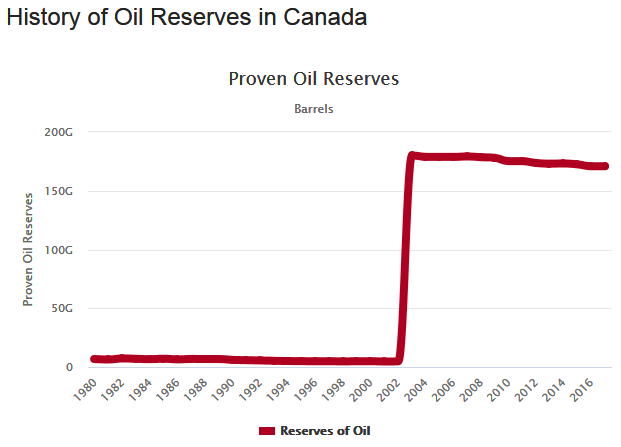mollwollfumble said:
Found this graph recently. Is this?
1. A huge new discovery
2. A major technological breakthrough
3. An accounting fudge
It’s been known forever that Canada has huge deposits of tar sands. Tar sands are valuable fuels in big combustion plants for electricity and heat generation (like coal), and useful for paving roads, but couldn’t be used to produce vehicle fuels because of the difficulty of removing the sand and because feeding sand into an internal combustion engine would damage the engine.
So is this huge jump in Canadian oil reserves just an accounting fudge – re-labelling tar sand as crude oil. Or is it major technological breathrough – a new cost-effective way to produce diesel from tar sand. Or is it a huge new discovery – nothing to do with tar sands?

Lock in number 2, a major technical breakthrough.
The crude bitumen contained in the Canadian oil sands is a highly viscous mixture of hydrocarbons heavier than pentanes which, in its natural state, is not usually recoverable at a commercial rate through a well because it is too thick to flow. Natural bitumen is oil having a viscosity greater than 10,000 centipoise under reservoir conditions. This is more solid than Venezeuala’s extra heavy crude.
Steam assisted gravity drainage was developed in the 1980s by the Alberta Oil Sands Technology and Research Authority and fortuitously coincided with improvements in directional drilling technology that made it quick and inexpensive to do by the mid 1990s. In SAGD, two horizontal wells are drilled in the oil sands, one at the bottom of the formation and another about 5 metres above it. These wells are typically drilled in groups off central pads and can extend for miles in all directions. In each well pair, steam is injected into the upper well, the heat melts the bitumen, which allows it to flow into the lower well, where it is pumped to the surface.
SAGD has proved to be a major breakthrough in production technology since it is relatively cheap, allows very high oil production rates, and recovers up to 60% of the oil in place. Because of its economic feasibility and applicability to a vast area of oil sands, this method alone quadrupled North American oil reserves and allowed Canada to move to second place in world oil reserves after Saudi Arabia. Most major Canadian oil companies now have SAGD projects in production or under construction in Alberta’s oil sands areas.
With present technology, the extraction and refining of heavy oils and oil sands generates three times the total CO2 emissions compared to conventional oil, primarily caused by the extra energy consumption of steam production.
But mollwollfumble notes that there’s still the problem that what you get out of it is still bitumen, not diesel, where does the hydrogen come from? Bitumen produced from the oil sands is not only heavy, but also contains heavy metals, corrosive salts and a significant amount of sulphur. It sometimes contains as much as 2% water and solids, which does not even meet pipeline specifications for transportation over long distances.
The first step in upgrading is dilution with “condensate”. This is followed by “upgrading”, which gets hydrogen from somewhere.
A second technological breakthrough is the “high conversion refinery”. “After spending billions converting refineries to accept more heavy/sour crude, US refineries, particularly in the Gulf Coast, found themselves short of heavy feedstock, increasing demand for Alberta’s diluted bitumen and narrowing the spread between light and heavy oil.” There are growing volumes of light and ultra-light oil being produced from US shale.


